MARIANI’S
December
13, 2009
NEWSLETTER
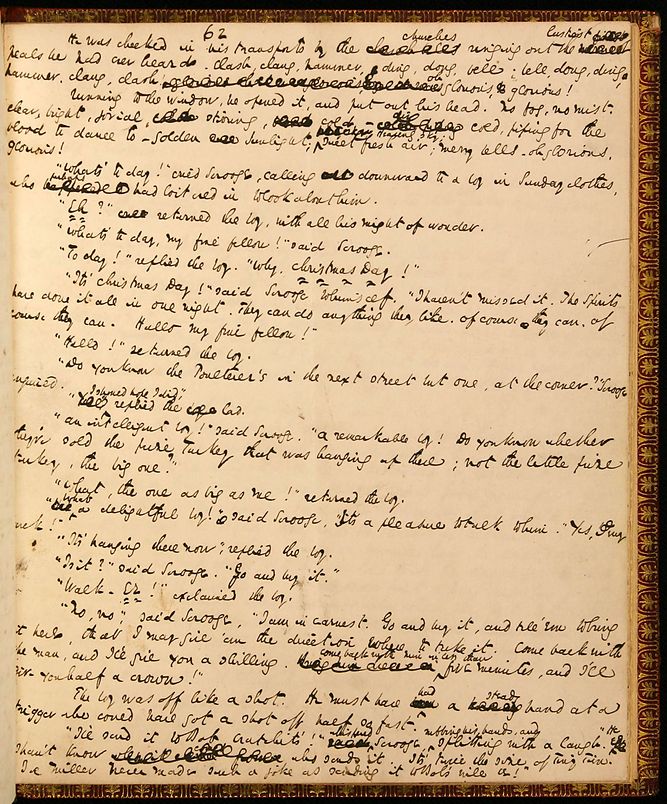
A Page from the original
manuscript of Charles Dickens' A
Christmas Carol (1843) of the scene where Scrooge wakes to
Christmas morning and asks a boy in the street to buy him a huge turkey
at
the butcher for Bob Cratchit's dinner. Now on display at The Morgan
Library, NYC. To read all the manuscript pages, posted by the NY Times, click
here.
~~~~~~~~~~~~~~~~~~~~~~~~~~
➔ QUESTIONS? TO REACH JOHN MARIANI WRITE TO: newsletter@johnmariani.com.
➔ ARCHIVE: Readers may now access an Archive of all past newsletters--each annotated--dating back to July, 2003, by simply clicking on www.johnmariani.com/archive
➔ SUBSCRIBE AND UN-SUBSCRIBE: You may subscribe anyone you wish to this newsletter--free of charge--by clicking here.
~~~~~~~~~~~~~
☛ In
This Issue
ST.
MARTIN À LA CARTE
by Edward Brivio
NEW
YORK CORNER: Crabtree's
Kittle House by John Mariani
by John Mariani
QUICK BYTES
~~~~~~~~~~~~~
ST. MARTIN À LA CARTE
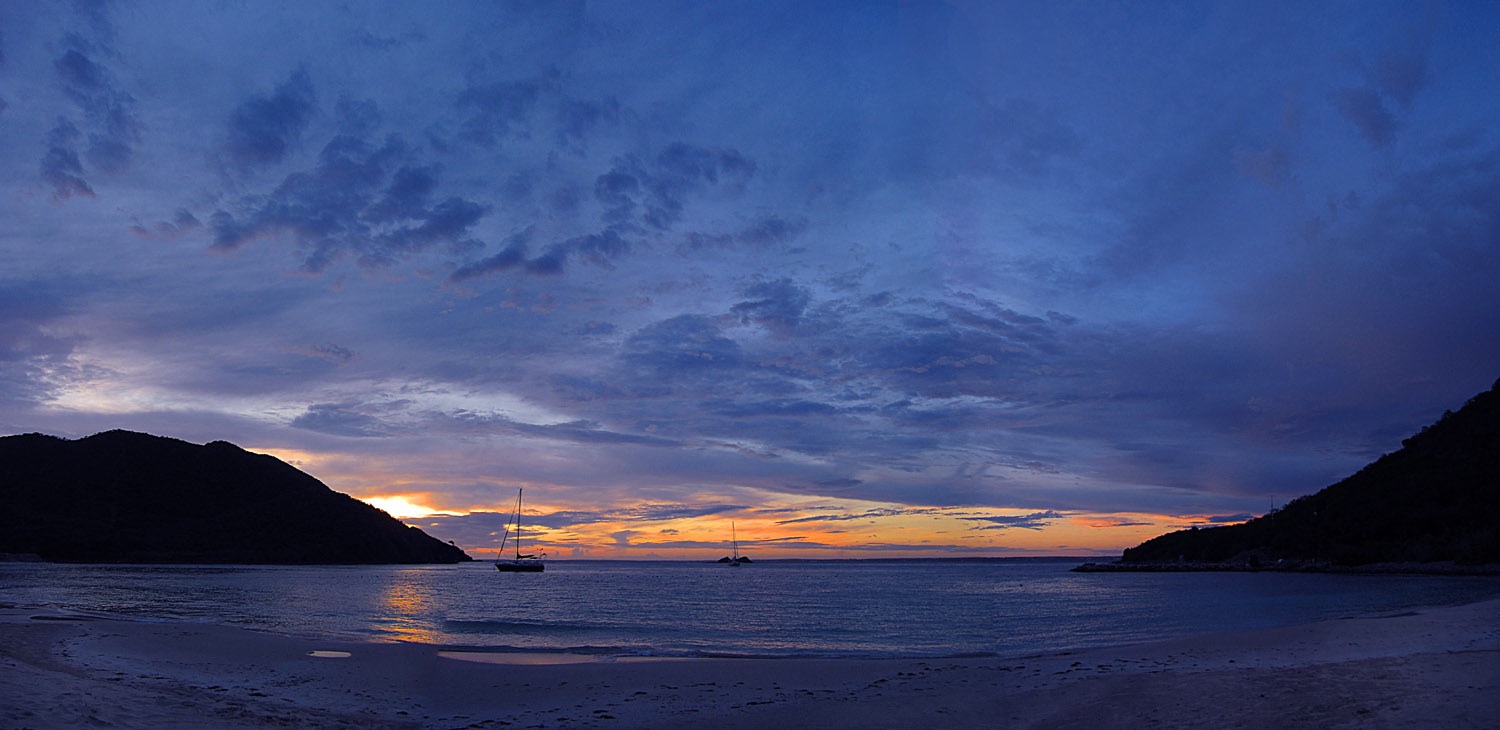
by Edward Brivio
Photos by Robert Pirillo
If
you’re longing for things French but need down-time on a sun-drenched
beach as well, then take your next vacation on the beautiful Caribbean
island of St. Martin. Half Dutch (Sint Maarten) and half French (Saint
Martin), the island‘s inhabitants have peacefully co-existed since a
treaty signed in 1648.
The Dutch side is where the cruise ships dock and
mega-yachts wandering the Caribbean find a safe haven in its numerous
marinas. If you’re into non-stop action: shopping, gambling, hordes of
cruise ship vacationers, and don’t mind busy streets and cheek-by-jowl
high rises of no particular architectural distinction, then stick to
the Dutch side clustered around the capital city of Philipsburg.
But for secluded beaches, undulating
hills, and building on a more human scale, however, head north to the
French part. We visited in early October; the rainy season had
just ended, so the hills/mountains (height-wise, they’re somewhere
in-between) that make the island so appealing were covered in greenery,
beach-goers were at a minimum, and getting reservations for dinner was
easy, although a number of restaurants were closed for the off season.
It
was also during the two- to three-week window each fall when
small, white butterflies blanket the island “like snow,” as the locals
are 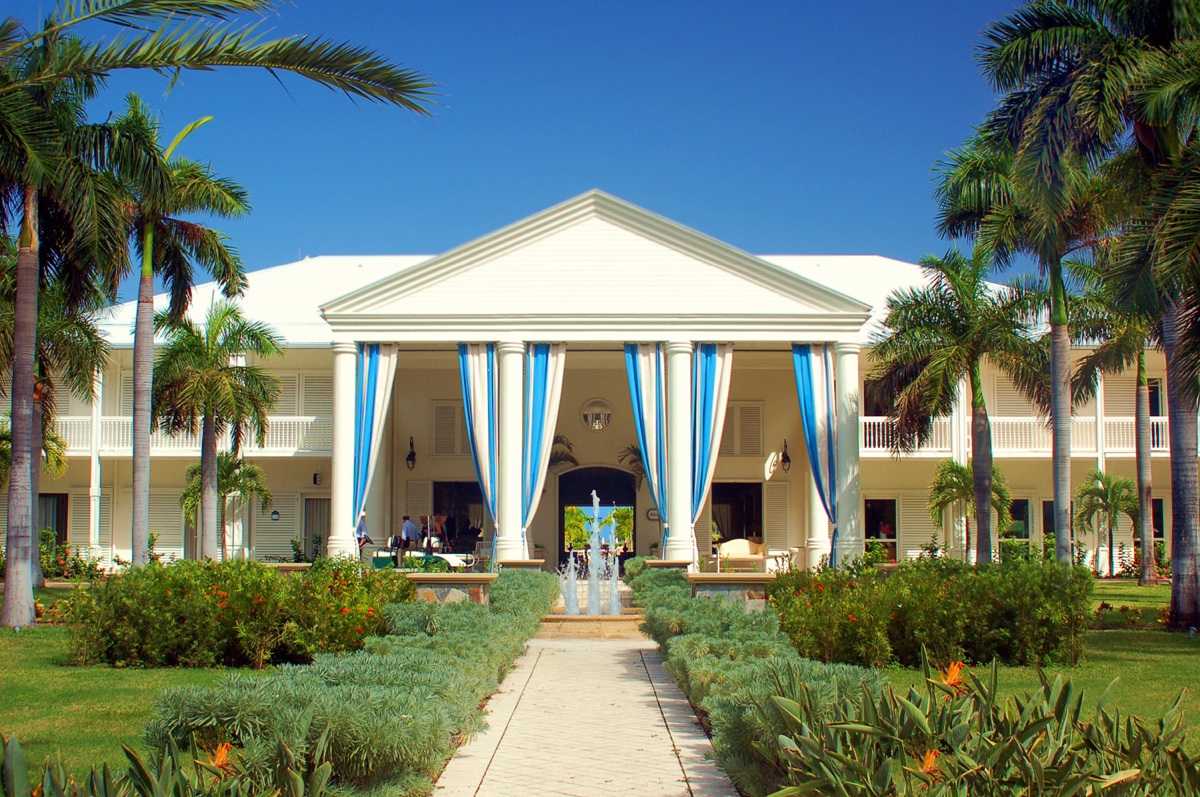 fond of saying.
fond of saying.
Near the northern tip of the island, the Radisson St. Martin Resort,
Marina & Spa on a small, secluded bay called Anse Marcel
--now protected as part of a marine preserve-- has just reopened after
two years of a complete renovation. Everything is brand new and fresh,
every inch is immaculate.
The Resort’s façade (right) conjures up the
great house of a colonial plantation but on an even grander scale.
Towering columns, a classical pediment, and billowing drapes some 20
feet tall form a monumental porte-cochère, flanked by
symmetrical
two-story wings, with verandas extending along the front. Inside, the
lobby is a large, breezy, high-ceilinged space, without lower walls at
either end. From the entryway, you have an uninterrupted line of sight
through the back of the building, across the patio and gardens, with
their twin rows of tall coconut palms, to the pool, and beyond, the bay
shimmering on the horizon.
High-end furnishings still manage to give off
a casual vibe. The welcome is warm, the smiles bright, the English
fluent; and the complimentary Planter’s punch, well-iced and delicious.
Straightaway, you begin to feel “island-time” take over. An enormous,
free-form pool (300 feet in length) with an infinity edge and a
good-sized Jacuzzi alongside is steps from the beautiful sandy beach.
Canvas-clad cabanas, with motorized shades that can be lowered for
privacy or to escape the Sun, are available for guests, as are free
snorkeling equipment and floats, as well as other water sports
equipment for hire. The floats are perfect for these warm, calm waters;
just don’t fall asleep.
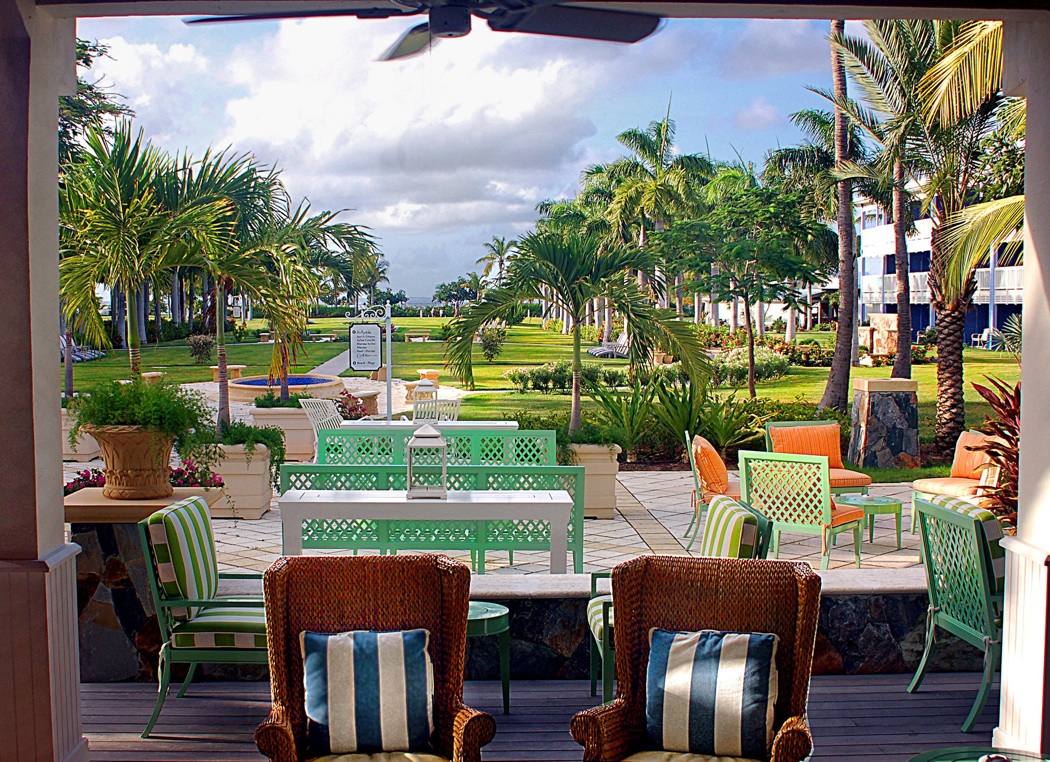 Guestrooms, in lovely, two-story, Wedgwood-blue and white
buildings surrounding the large garden courtyard include Superior and
Deluxe Doubles, Marina Suites, even more luxurious Grand Suites, and
finally, a habitation of Presidential proportions known as the Anse
Marcel Suite. Our roomy Marina suite (left)--living
room, bedroom with
king-size bed and spacious marble bathroom with both a walk-in shower
and a large bathtub--had balconies at either end, one facing the
gardens, in front; and the other, overlooking the small marina and
narrow channel that provides it an outlet to the sea, in back.
Guestrooms, in lovely, two-story, Wedgwood-blue and white
buildings surrounding the large garden courtyard include Superior and
Deluxe Doubles, Marina Suites, even more luxurious Grand Suites, and
finally, a habitation of Presidential proportions known as the Anse
Marcel Suite. Our roomy Marina suite (left)--living
room, bedroom with
king-size bed and spacious marble bathroom with both a walk-in shower
and a large bathtub--had balconies at either end, one facing the
gardens, in front; and the other, overlooking the small marina and
narrow channel that provides it an outlet to the sea, in back.
Here was the perfect spot for alfresco
lounging in the evening, with the tree frogs going at it in unison on
the hill across the way, the dark waters of the channel flowing quietly
by, occasionally a vessel gliding past, and, off to the right, the
placid marina filled with beautiful boats. One night, a storm came up.
Freshening breezes soon segued into a rousing son et lumière
display: howling winds, rolling thunder, torrential rains, and bolts of
lightning, all viewed from a front-row seat on our balcony
sheltered under the wide eaves of its roof.
Called simply “C,”
the resort’s
signature restaurant (below)
is right at water‘s edge, with nothing but a low
stone wall between you and the breaking waves. The dining room is
spacious, mostly white, and open-air: a timber-framed “shell” with no
exterior walls. Sturdy uprights support a lofty, sloping, open-timbered
roof of exposed beams and rafters. Ceiling fans, and a constant breeze
off the water keep it cool, while large canvas shades can be lowered if
the weather turns bad.
Starters here include a cool and refreshing
salade nicoise au thon, marred only by rather bland potato slices, and
a well-made Caesar salad, with each torn leaf of Romaine coated but not
soaked in the flavorful dressing, grated Parmigiano, crisp croutons,
and OMG! Could it be? fresh anchovies, little-known this side of the
Atlantic, but one of the sea’s great treasures. Slices of flame-seared
Yellow-fin tuna, set off by a lively mango salsa, were garnished with a
caviar de melon, spheres of cantaloupe so tiny and glossy that they did
resemble fish roe, and, for another touch of whimsy, an air de citron
or lime “foam,” that was actually quite tasty. For a more
substantial send-off, there’s an assiette de jambon de Bayonne et fromage basque avec beurre
demi-sel, one of the world’s great hams, and a semi-hard,
ewe‘s-milk cheese named Ossau-Iraty, both indigenous to the foothills
of the Pyrenees, and that superb butter, all served with slices of
rustic farmhouse bread and a small salad of radicchio and mixed greens.
Long gone is the island’s fishing fleet, but
fresh seafood remains a prime menu item, and Executive Chef Bruno
Brazier realizes that the less you fuss over it, the better. A filet of
red snapper and a filet of mahi-mahi were both beautiful pieces of
fish, simply grilled, the first with a sauce of extra virgin olive oil
and aromatic herbs, and the mahi-mahi with a sauce provençale
based on tomato, garlic, and olive oil. Prawn brochettes with a
coconut/ginger curry sauce, and a fresh Caribbean rock lobster with
basmati rice and baby vegetables also benefited greatly from their time
on the grill, the shrimp vaguely smoky, the curry sauce, clean and
fresh, and the lobster well-prepared, but I thought the rice and
steamed veggies a bit bland and pedestrian alongside it.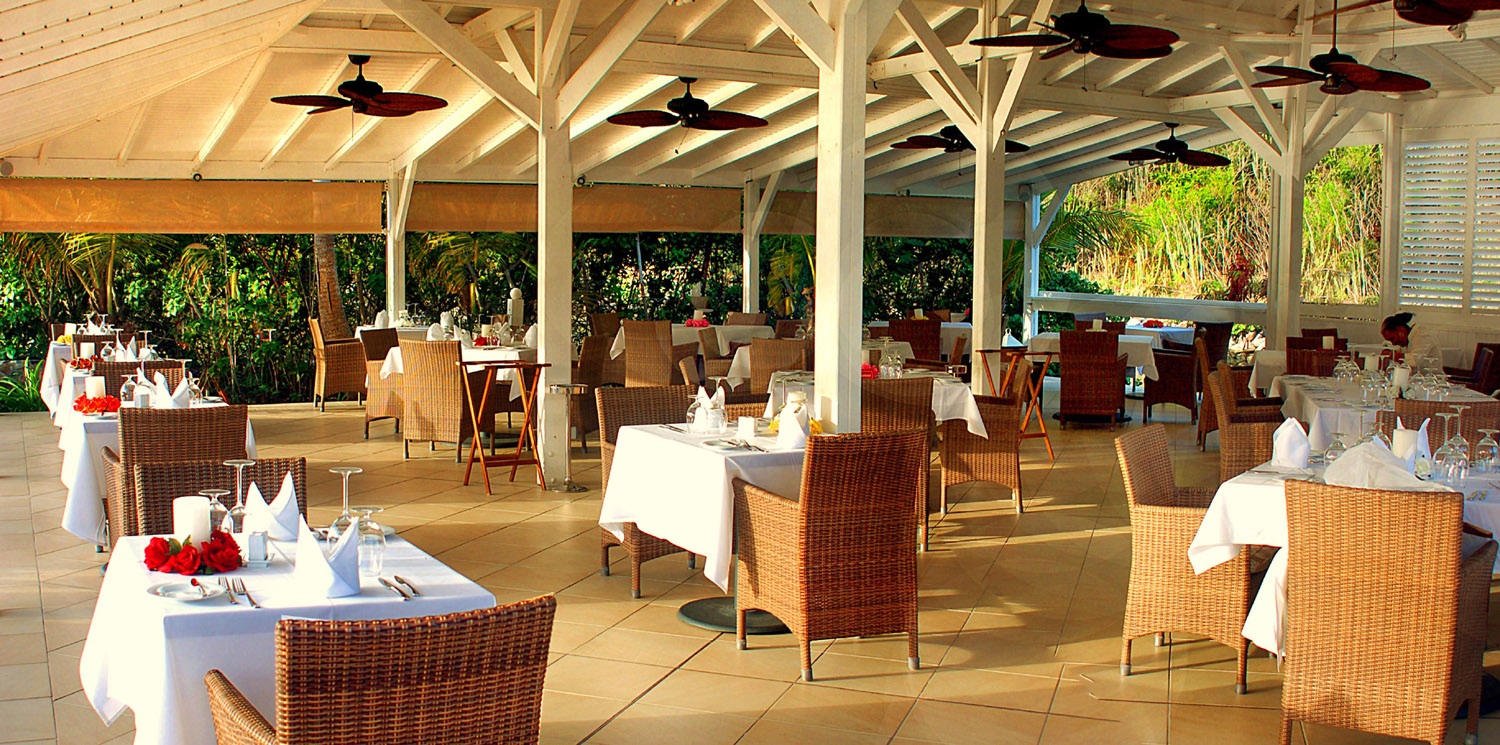
There’s also filet de bar et langouste en choucroute de
papaya, the sea bass and good-sized pieces of rock lobster tail
cooked en papillôte
(with clean, delicate flavors that matched those of the shredded green
papaya (the choucroute) cooked with it. For a change of pace try
the mignon de veau en croûte
doré aux morilles, the loin of veal baked in a pastry
crust containing morels and asparagus tips on the side, as well as a
phyllo “pouch” enclosing delicious scalloped potatoes.
The pastry chef at “C” turns out
picture-perfect French pastry, often, with an island twist.
Scrumptious, over-sized coconut macaroons, perfect creations in their
own right, arrived one night filled with raspberry ice cream, and the
next, with mango ice cream and chocolate sauce. A beautiful vacherin
exotique sauce aux fruits rouges--the vacherin, or frozen meringue,
another classic creation of the pâtissière’s art as
unimpeachably French as Racine--was rendered exotique by the fresh
mango and lime-juice sorbet within. And a warm pineapple and mango
crumble with custard sauce, was dessert as Caribbean comfort food.
We drank four wines from the well-chosen wine
list.Frank Phelan 2002 (59 euros), is the 2nd wine of St.
Éstephe’s Phélan-Ségur, one of nine Crus Bourgeois
exceptionnels. It bears the name of estate founder, Bernard Phelan’s
son, Frank, who was mayor of St. Éstephe for 30 years. Big,
robust well-rounded, and with firm tannins, it was a characteristic St.
Éstephe, but in a minor key. Morgon is one of the best of
the Beaujolais Crus, so when you find a good one, you’re in for a
treat, and a bargain. Michel Picard’s deeply colored Morgon 2006 (34
euros) had Gamay’s lovely strawberry fruit, but richer and more
powerful than in your run-of-the-mill Beaujolais, along with the
medium-to-full body and silken texture of a good red Burgundy. The
Ferrari-Carano Fumé Blanc Sonoma 2006 (32 euros), was a
fragrant, dry Sauvignon Blanc, with ripe citrus and tropical fruit
flavors. Aged in a combination of stainless steel and older French oak,
it managed to be crisp and fresh, and still have a nice, creamy body, a
whiff of smoke, and just enough acidity to balance them. We also had a
Côte de Beaune Villages 2005 (55 euros) from Chanson which, try
as hard as it did to be a good basic red Burgundy, never quite made it.
Letting it breathe hardly helped at all, it was still somewhat thin and
tight.
Starters at C run 9 to 16 euros, 35 for langouste; entrees: 25 to 35; desserts: 6 to 9.
St. Martin’s renown
as the “culinary capital of the Caribbean,” is mainly based on a
string of restaurants lining both sides of the main boulevard in
the town of Grand Case, a long stretch of sandy beach, a short 10 to 15
minute drive from the Radisson. Two of the best are L’Escapade, already
with an impressive track record, and the recently opened La Villa.
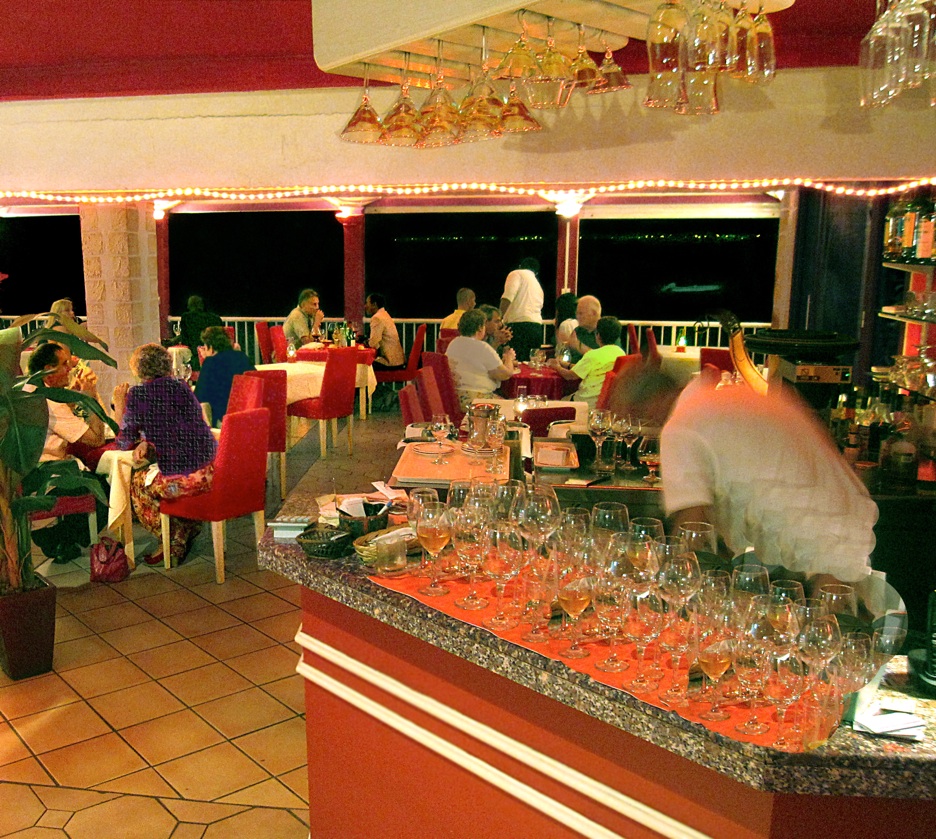 Why at first sight, did L’Escapade (below) remind me so much of
a classic, New York, theatre-district, French restaurant, say Tout Va
Bien or Pierre au Tunnel? Maybe that step down into the dining
room, or the strings of small, white lights outlining some of the
walls, maybe, the sight of le patron wiping glasses behind his cozy,
congenial bar off to the right or the menu in its paperboard folder?
Whichever it was, I knew upon entering that despite the tropical heat,
the Caribbean right outside the open-air dining room, and the lights of
Anguilla in the distance, I was, nonetheless, unmistakably on French
“soil.” And all the better off for it.
Why at first sight, did L’Escapade (below) remind me so much of
a classic, New York, theatre-district, French restaurant, say Tout Va
Bien or Pierre au Tunnel? Maybe that step down into the dining
room, or the strings of small, white lights outlining some of the
walls, maybe, the sight of le patron wiping glasses behind his cozy,
congenial bar off to the right or the menu in its paperboard folder?
Whichever it was, I knew upon entering that despite the tropical heat,
the Caribbean right outside the open-air dining room, and the lights of
Anguilla in the distance, I was, nonetheless, unmistakably on French
“soil.” And all the better off for it.
Between greeting guests warmly, handing out
menus while describing the specials, and, finally, taking coffee and
after-dinner drink requests, our host that night, Sergio spent as
much time in front of the bar as behind it.
Foie gras three ways, I couldn’t pass it up.
The Trilogie : a good-sized piece, seared, and served with a chocolate
sauce (an unexpectedly successful pairing); a slice that had been
marinating in sweet wine; and finally a pâte de foie gras,
each delicious in its own way, and quite reasonable at 24 euros.
Lobster bisque “cappuccino” style, was indeed covered with a thick
mousse above a creamy soup, based on a rich shellfish stock.
Soupière
de coquillages et crustaces had
nothing to do with soup, other than the soup bowl, soupièr, it
was served in. Sautéed sea scallops, flathead lobster, and jumbo
shrimp vied for attention in an inspired lemongrass/ginger sauce.
Marmite de poissons et crustaces
was indeed a soup, a rich fish
soup chockablock with hunks of fish, shrimp, scallops, and a rock
lobster tail, garnished with an irresistible aïoli, croutons and
grated cheese.
To cool off for dessert, order perfectly baked
profiteroles, or cream puffs, filled with vanilla ice cream, and a
lightly-flavored almond whipped cream, topped with a warm
chocolate-peanut sauce. After that, all we needed was an excellent
short espresso.
Fifty-eight euros bought a 2006 Cellier aux Moines, Givry,
one of my favorite appellations for Old World pinot noir pleasures .
Appetizers: 11 euros to 24; entrees: 26 euros to 38: desserts: 11 euros to 15.
The dining
room at La Villa (right) recalls a rustic, farmhouse
interior, with fieldstone floors, stucco walls pierced by arched
windows, and a steeply peaked roof with exposed timbers.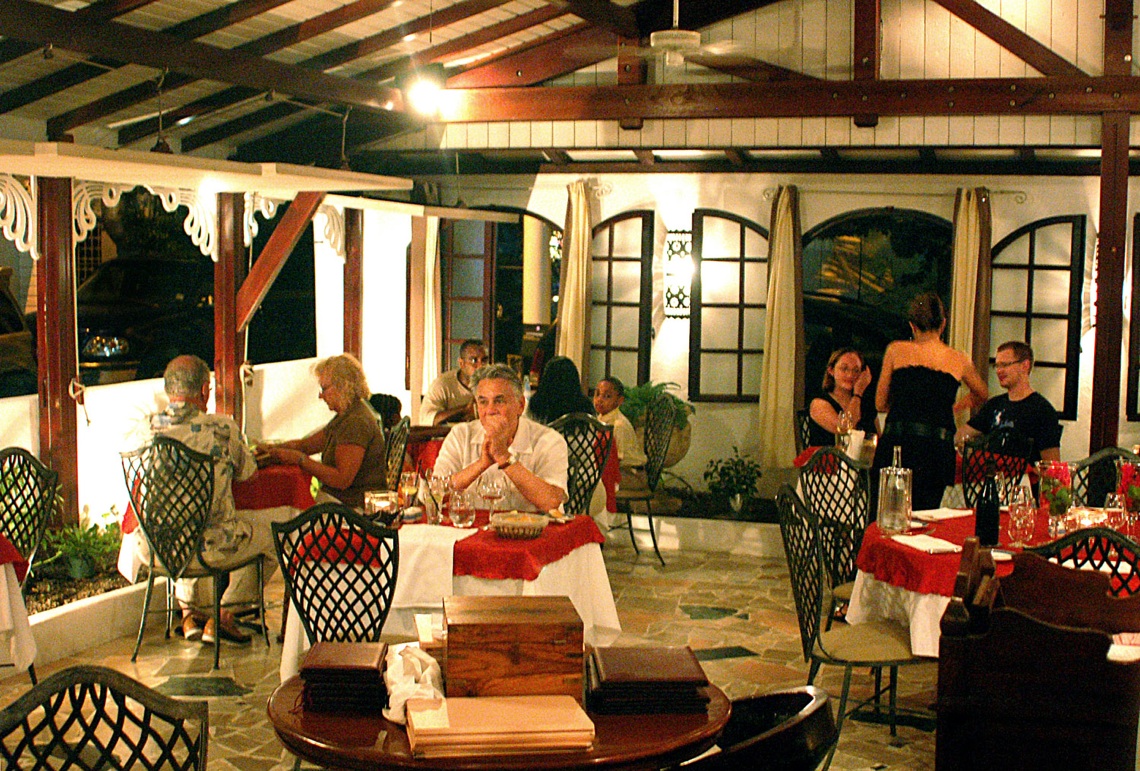
Another fine example of a soupe de poissons,
once again with its usual accompaniment: croutons, aïoli, and
grated cheese (here, Emmenthal), rich with the flavor of the sea from
its carefully made shellfish stock. Perhaps, the best dish I had on the
island was the nems du canard,
duck egg rolls, with an orange and
ginger sauce, served here. Crisp, well-drained and hot from the fryer,
they disappeared all too quickly, and the sweet/sour dipping sauce
alongside had the unmistakable tang of freshness. Another standout was
the seared tuna steak with a thick crust of coarsely grated peppercorns
adding real flavor, served with a delicious crab risotto. Here playing
the role of side dish, the risotto is also available as a pasta and
well deserves its stand-alone stature. Chilean sea bass was surrounded
by garnishes, each as delicately flavored as the fish itself: a
wonderful leek fondue, and a light, riesling cream sauce with clams.
Even with AC, dining rooms here were still a bit
warm, so profiteroles with vanilla ice cream and chocolate sauce
beckoned and were delicious, artfully presented on a square plate
framed by a smear of chocolate sauce on top, two squiggles of raspberry
sauce for the sides, and perfect drops of passion fruit on the bottom.
Sancerre rouge, when good, is an excellent way
to enjoy the charms of Old world pinot noir while avoiding the
stratospheric prices of red burgundy, and the Domaine Henri Bourgeois,
2006 Sancerre “Les Baronnes” (from vines 25 to 40 years old), on the
wine list here, was quite good, and one of the lower-priced items at 38
euros.
Overall, this was our favorite meal on the island,
and the casual yet elegant dining room, as well as the warm hospitality
of owners, Cristophe (the maître’d) and Florence (sommelier and,
when needed, waitress) create the perfect setting for Chef Jean-Pierre
Yeponde’s refined cuisine.
Appetizers: 9 euros to 15; entrees: 24 euros to 29; desserts 9 to 12.
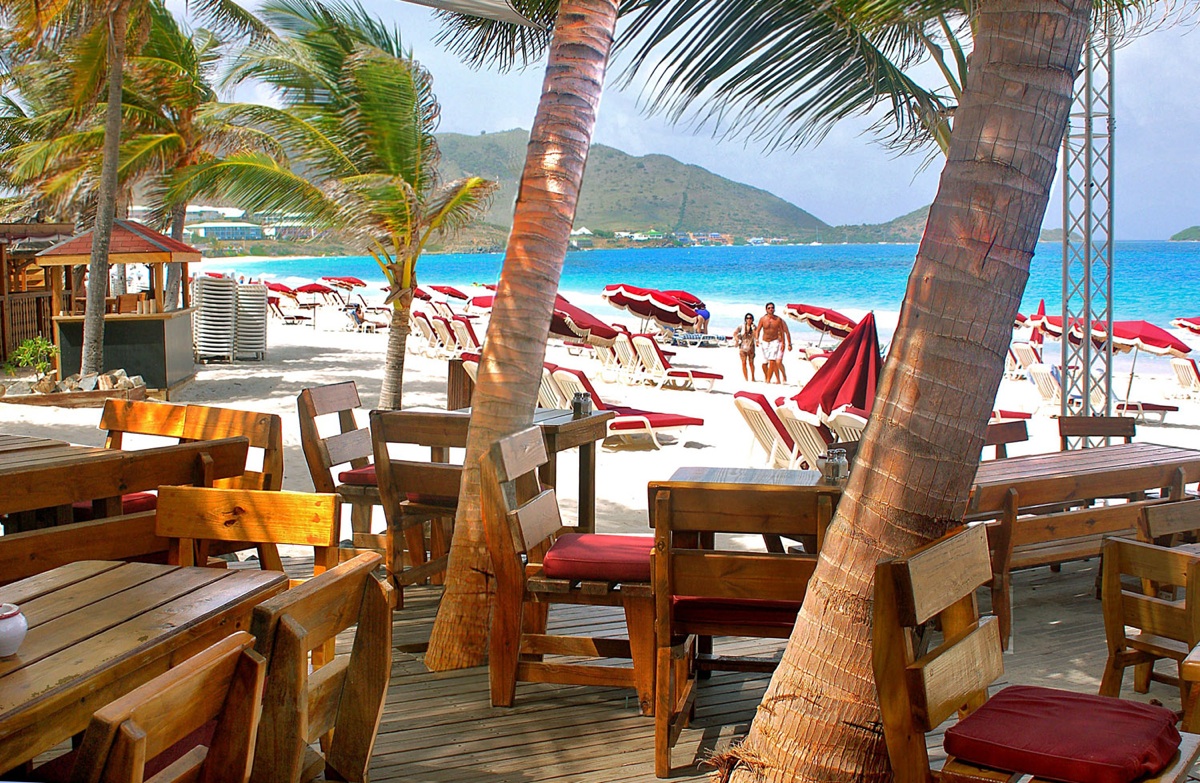
Orient Beach, one
of the island’s most popular beaches, is a mile long stretch of warm
sand and turquoise sea, containing a handful of open-air, beach
bars/restaurants. One of the best here is the oddly named Waikiki
Beach (left) right at
waters-edge. The most basic of post-and-beam structures, over a deck
set right on the sand, with no exterior walls, just vertical uprights
and horizontal joists supporting an open-timbered, gable roof, all of
it rugged, bare wood, it’s the kind of breezy, laid-back place where
you might dine in your bathing suit.
I didn’t realize how much I wanted lunch until
a bowl of Waikiki’s super Black Tiger Shrimp tempura--crisp, hot, and
done to a turn--was placed before us. Conversation paled as all our
attention quickly turned to gobbling them up, due, in no small part, to
the addictive honey/soy dipping sauce alongside. Soon followed a feast
of grilled seafood, presented simply on a bamboo mat over a large oval
platter (right). Rock lobster
tails, shrimp on skewers, and filets of sea bass, mahi-mahi, and
swordfish surrounded a bowl of potent aïoli, and a second filled
with an equally good tomato rouille.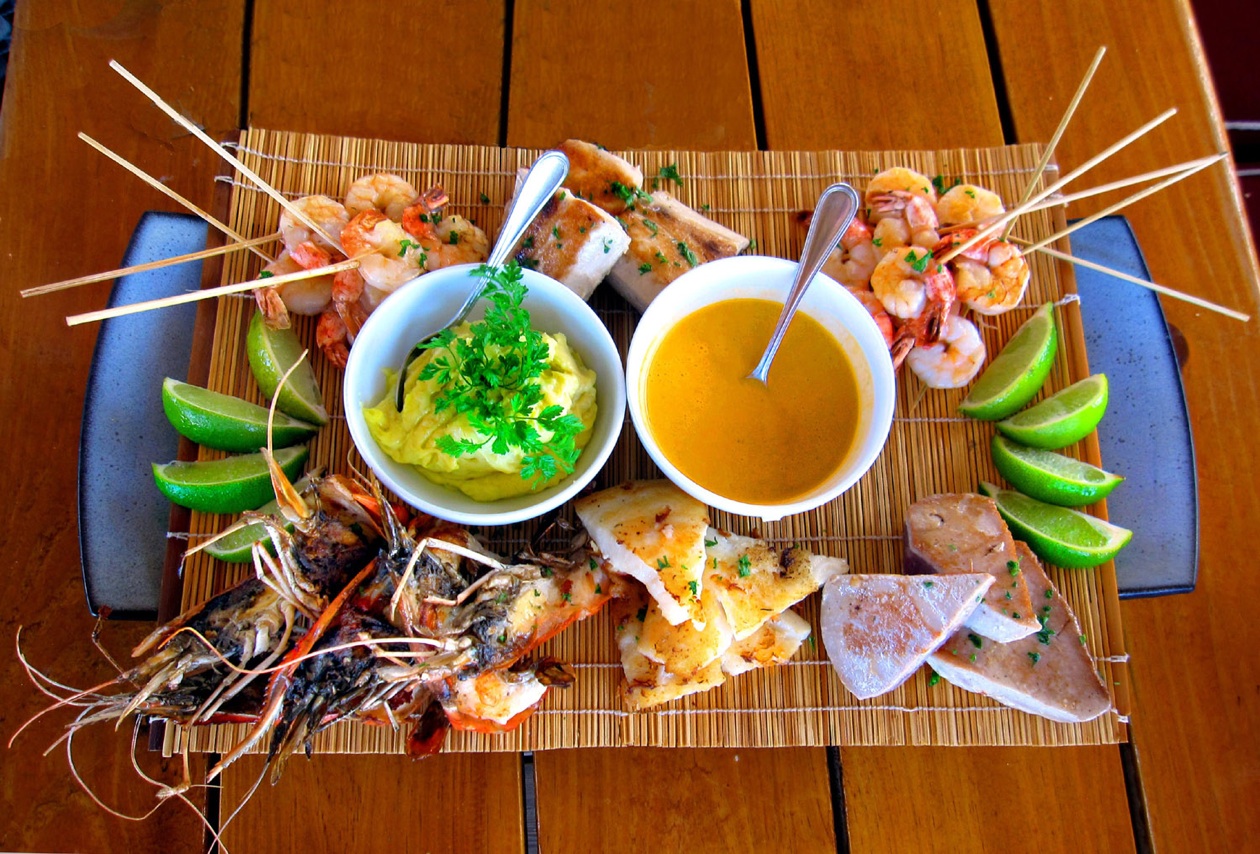
Expect to pay about $50 a person for lunch.
Chaises-longues and umbrellas are also available if you want to
hang-out here after lunch.
The best
way to see any island is by boat. Marine Time Charters not only
provided water transfer from airport to
hotel--if you can afford it, do it-- but also took us on a half-day
outing to two nearby islands, on their ScoobiCat, a 36 foot catamaran
with two powerful outboard motors.
Around the northern tip of St Martin is the
uninhabited island of Tintamarre. Day-trippers arrive by boats for a
day of sun, sand, and surf, pretty much as Mother Nature intended.
There are no services on the island or “ferries“ to it. Visitors must
bring in all supplies. Which, of course, is the whole point. We stopped
to snorkel around its rocky western tip, but the fish weren’t showing
very well that day.
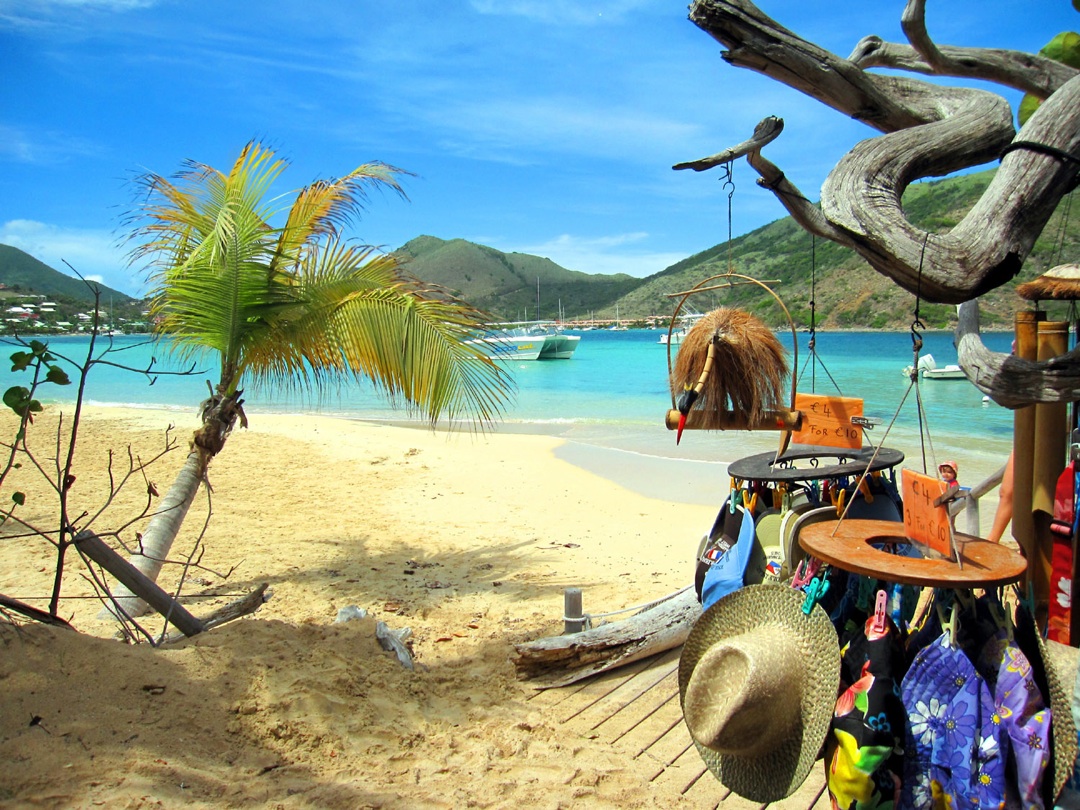 Next we anchored in the shallow water off Pinel Island (below): at first sight, nothing
more than a sand spit anchored by a stand of tall coconut palms, a
scattering of palm-fringed huts amidst the trees, and behind, a
low, shrub-covered hill. A favorite with locals and tourists alike --a
5- to 10-minute ride on a small “ferry” (really, an over-sized
row-boat) from Orient beach -- the island’s main beach is lined with 3
beach-bar/restaurants, Yellow Beach, Le Karibuni, and, the newcomer, Up
on the Key, as well as the Paradiso gift shop.
Next we anchored in the shallow water off Pinel Island (below): at first sight, nothing
more than a sand spit anchored by a stand of tall coconut palms, a
scattering of palm-fringed huts amidst the trees, and behind, a
low, shrub-covered hill. A favorite with locals and tourists alike --a
5- to 10-minute ride on a small “ferry” (really, an over-sized
row-boat) from Orient beach -- the island’s main beach is lined with 3
beach-bar/restaurants, Yellow Beach, Le Karibuni, and, the newcomer, Up
on the Key, as well as the Paradiso gift shop.
Housed in tiki-hut style structures, Yellow Beach
beckoned, especially its cool, shady interior. When we sat down, I
realized our money was on the boat. “No matter,” we were told, the
oh-so-welcome fruit punches were on the house. The Paradiso
boutique, in a grove of sea grape, feels like an intriguing mini-casbah
under its canvas cover. The shade gets noticeably cooler as you venture
towards its center, where you’ll find the remarkable gentleman who runs
the place, whose gracious smile, cordial welcome, and super-casual
demeanor are part of what makes the island special.
Despite its popularity, and busy shoreline, Pinel is
still “a little bit of Paradise,” only with all the amenities, and
close-by. Besides, if you need to get even further “away from it all,”
a short hike takes you to the other side of the island, and two all but
deserted beaches.
~~~~~~~~~~~~~~~~~~~~~~~~~
NEW
YORK CORNER
by John Mariani
Crabtree's
Kittle House & Inn
11
Kittle Road
914-666-8044
www.kittlehouse.com
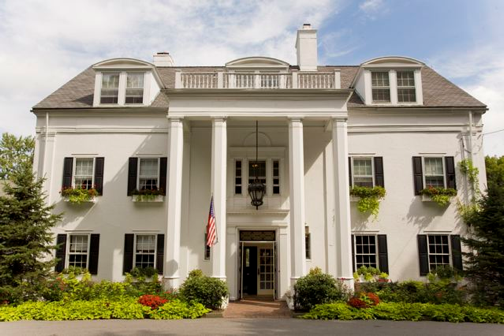
Its large windows overlook the fine expanse of Hudson Valley greenery that has served as the backdrop for countless weddings and celebrations at the Kittle House, which has several private dining rooms and a wine cellar option,
 along with a Tap Room with a bar
originally found in a Bronx speakeasy. There are also 12 guest rooms
for overnight stays, ranging from a very reasonable $147-$167 per
night. By the way, that wine cellar is overseen by managing partner and
wine director Glenn Vogt (right),
whom many, including myself, consider one of the finest, most
knowledgeable, and most genteel hosts in the business. Vogt
maintains a superb collection (with a Wine
Spectator Grand Award since 1994) of 5,000 selections and
60,000 bottles,
with rare,
large format and signed bottles from throughout the past century; more
than a thousand bottles are priced under $75.
along with a Tap Room with a bar
originally found in a Bronx speakeasy. There are also 12 guest rooms
for overnight stays, ranging from a very reasonable $147-$167 per
night. By the way, that wine cellar is overseen by managing partner and
wine director Glenn Vogt (right),
whom many, including myself, consider one of the finest, most
knowledgeable, and most genteel hosts in the business. Vogt
maintains a superb collection (with a Wine
Spectator Grand Award since 1994) of 5,000 selections and
60,000 bottles,
with rare,
large format and signed bottles from throughout the past century; more
than a thousand bottles are priced under $75.Over the 30 years or so I've dined at the Kittle House several chefs, some very fine, some thoroughly mediocre, have passed through the kitchen, which once seemed more intent on getting hundreds of banquet meals out than pay attention to the public dining room. But that was long ago,
 and now a new chef is onboard--Bradford
McDonald (left), a
Mississippian who graduated from Per Se and Alain
Ducasse at the Essex House in NYC, who is very dedicated to rigorously
seasonal menus--the à la carte dinner menu is strikingly
improved to show off his individual talents.
and now a new chef is onboard--Bradford
McDonald (left), a
Mississippian who graduated from Per Se and Alain
Ducasse at the Essex House in NYC, who is very dedicated to rigorously
seasonal menus--the à la carte dinner menu is strikingly
improved to show off his individual talents.We began dinner with a luscious amuse of smoked bone marrow custard topped with very fine California osetra caviar, a little cupful that was just enough to perk the appetite. Pan-seared sea scallops (below), just past translucence, took on the wintry complement of green apple and golden chanterelles with a verbena puree. Gnudi--like gnocchi--were made from ricotta, nicely firm, not too soft, served with sweet tomatoes, basil, and a "Niçoise crumble" of herbs. Red beets were laced into farrotto grain, which the Roman legions once traveled on, but I suspect they didn't have the luxury of added duck prosciutto or a hazelnut praline sauce. Spaghetti squash carbonara was a light and lovely idea, with a hen's egg whipped into a sabayon, with smoked bacon and a parmesan foam--not the heft of spaghetti carbonara but it was a smart take on the
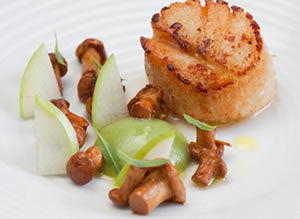 old Roman classic.
old Roman classic.There was a heavy hand with salt that night in the kitchen, and it marred the flavor of roasted chicken with black trumpet mushrooms, radishes, butternut squash puree, and a sauce perigourdine, as well as a fine white Chatham codfish fillet with kale, toasted garlic, and bottarga emulsion, this last providing its own shot of saltiness. The Colorado loin of lamb was of excellent quality, served with red bliss potatoes, braised swiss chard, thyme oil, and a lamb jus. Drawing on the region's larder, McDonalds serves a Hudson Valley Moulard duck breast with vanilla-scented parsnips, sour cherries, nebrodini mushrooms, and duck jus--a balance of the classic, the modern, and the personal.
There is a selection of cheeses available and a good array of desserts, from a dark chocolate cremeaux tarte with raspberry dust and pistachio gelato, to an enticingly smooth and rich Alsatian cheesecake with raspberry coulis.
McDonald and Vogt bring to the Kittle House not what it has long lacked so much as an upgrade in everything across the board, so that everything from a la cartye dining to a wedding feast are now in admirable synch in a place that has never been lovelier, at any time of year.
Crabtree's Kittle House is
open for lunch Mon.-Fri., for dinner, nightly; for brunch Sun.
Appetizers run $12-$16, entrees $28-$36. There is also a $35 fixed
price menu and a $60 tasting menu, with wines, $90.
~~~~~~~~~~~~~~~~~~~~~~~~~~~~~~~~~~~~~~~~~~~~
NOTES FROM THE WINE CELLAR
Ferragamo's
Latest Line Is Eminently Drinkable
by John Mariani
Don’t bother going to a
wine store and asking for the new line of Ferragamo wines. The brand
adorning $1,600 leather boots isn't on the bottles because the family,
being extremely genteel, thinks it in poor taste.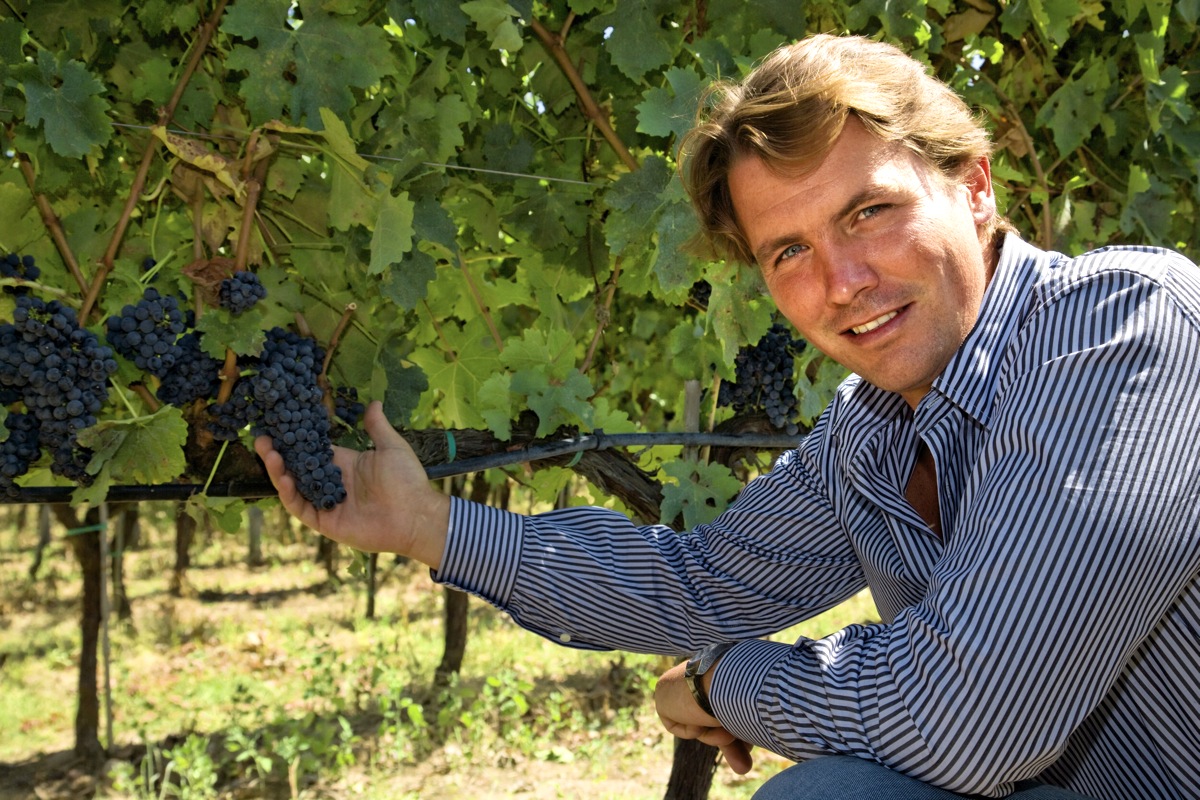
Instead they use names like Il Borro, a
Tuscan
estate spread over 175 acres, with 40 dedicated to
vineyards. Salvatore Ferragamo (right),
37, the tall, blue-eyed grandson
of the company’s late founder, Neapolitan-born Salvatore, recently
introduced the wines to the trade and media at a tasting on the patio
of the Ferragamo showroom on New York’s Fifth Avenue.
“The estate dates back to 1760 in the
noble Medici-Tornaquinci family,” Salvatore said at the tasting, “My
father Ferruccio used to hunt with Duke Amedeo D’Aosta, who owned the
property until 1993, when we bought it and brought it back from almost
complete decay.”
The Ferragamos restored the grand villa
and country houses on the estate and turned it into a winery and a
resort (below), which
Salvatore now manages. Daily rates, now in low season, run from 200
euros ($302) to 1,500 euros per night, with a 3-night minimum.
Wines have always been made
on the estate and the Ferragamos hired enologist Niccolo D'Afflitto in
1999 to improve the quality. The winery opened in 2007, with four
labels under the IGT (indication of geography typical of the region)
appellation decreed by Italian wine laws.
With D’Afflitto and enologist Cecilia
Leoneschi, Ferragamo also makes wines on estates around Montalcino such
as the 4,500-acre Castiglion del Bosco.
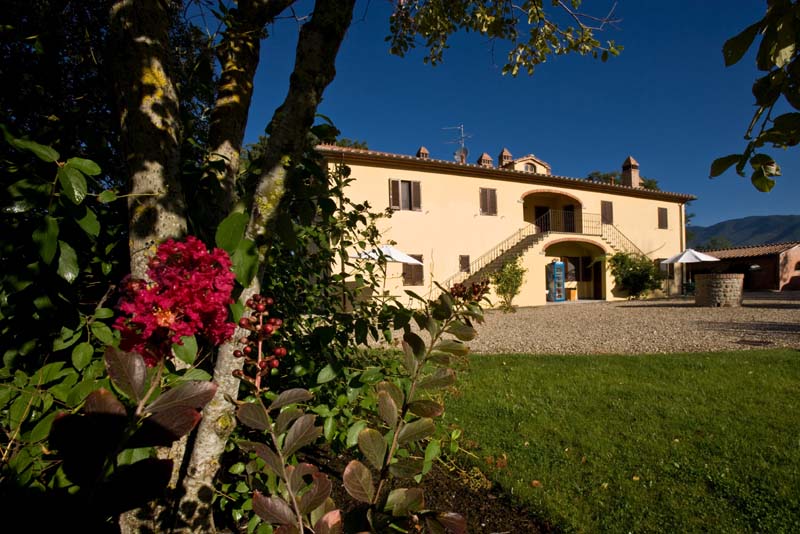 Eight wines were presented at the
New York tasting, along with platters of prosciutto, Parmigiano cheese,
focaccia, and Tuscan crostini toast slathered with chicken liver paste
-- the kind of food whose fat content enhances the wines on the palate.
To begin, there was Il
Borro Lamelle Chardonnay 2006 ($24), which spends 8-10 days in
both oak and stainless steel, then two months in oak, followed finally
by two months in the bottle before release. At 12.5 percent alcohol,
its structure is much closer to the finesse of French Burgundies than
the powerful, over-oaked Californian style. It is ideal with simple
seafood and pastas in cream and butter sauces.
Eight wines were presented at the
New York tasting, along with platters of prosciutto, Parmigiano cheese,
focaccia, and Tuscan crostini toast slathered with chicken liver paste
-- the kind of food whose fat content enhances the wines on the palate.
To begin, there was Il
Borro Lamelle Chardonnay 2006 ($24), which spends 8-10 days in
both oak and stainless steel, then two months in oak, followed finally
by two months in the bottle before release. At 12.5 percent alcohol,
its structure is much closer to the finesse of French Burgundies than
the powerful, over-oaked Californian style. It is ideal with simple
seafood and pastas in cream and butter sauces.
Il
Borro Pian di Nova 2006 ($24) is made from an unusual blend, for
Tuscany, of 75 percent syrah and 25 percent sangiovese. At a reasonable
13 percent alcohol, you don’t get that syrah burn or too much ripeness
out of the fruit. It’s a big, thick, chewy wine, however, with the
ballast of sangiovese tannins that make it a good match with game
dishes.
Castiglion
del Bosco Dainero 2004 ($15) is 90 percent merlot with 10
percent sangiovese that gives a bit more character to the merlot than
northern Italian examples usually show. There isn’t much complexity
here, but at $15, it's pretty wonderful. Castiglion del Bosco Rosso di Montalcino
2005 ($21) is a more traditional wine of the region, made with
100 percent sangiovese at 13.5 percent alcohol. More and more I am
impressed with rosso di montalcino, the
illustrious brunello di montalcino’s lesser brother, because I find it
easy to drink at a younger age.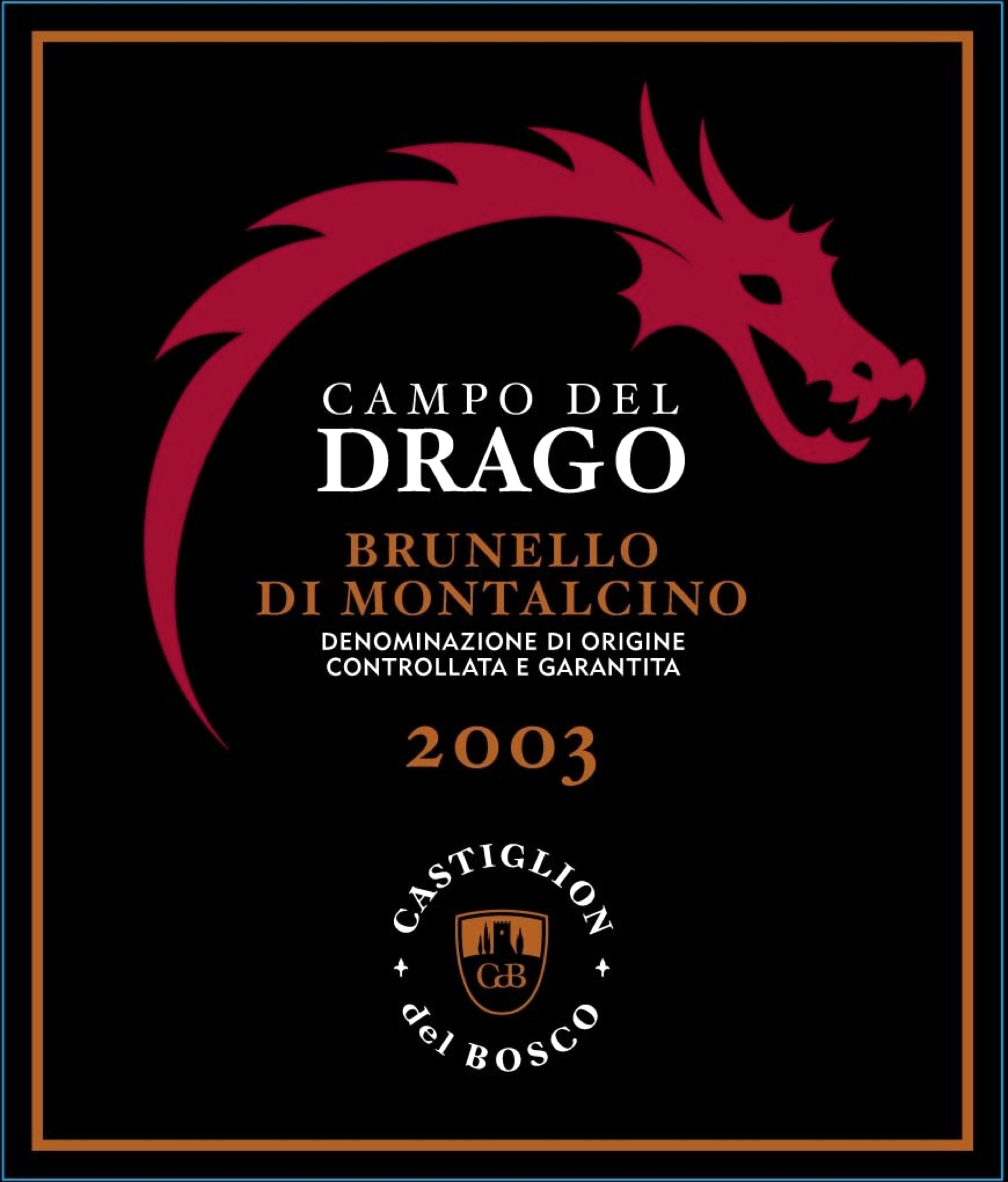
While
not having the same body and complexity as brunellos, rosso di
montalcinos are excellent Tuscan wines on their own. Ferragamo’s
had a brilliant ruby color and a gorgeous bouquet. It's still tannic,
but within the next year, should emerge as a very fine example of this
increasingly delightful red.
Castiglion
del Bosco Brunello di Montalcino 2003 ($50), by law 100 percent
sangiovese grosso, with 14 percent alcohol, was swirled in the glass
with a slightly musty aroma that dissipated to reveal abundant fruit
and a remarkably forward development for a young brunello. You could
take great pleasure in it now with a peppered bistecca alla fiorentina,
but wait a year or two and I think you’ll really be amazed at its power
and refinement.
Castiglion
del Bosco Campo del Drago 2003 ($80), also a brunello, is a
bigger, very tannic wine now, with a powerful nose that bursts from the
glass and a blanketing richness as it falls over the palate. This may
take a little time to mature fully, but the wait will be worth it.
For the most part, prices for these wines
are amazingly reasonable -- the rosso di montalcino is a steal at $21
-- and just the thing to drink while wearing your $790 tassel loafers.
~~~~~~~~~~~~~~~~~~~~~~~~~~~~~~~~~~~~~
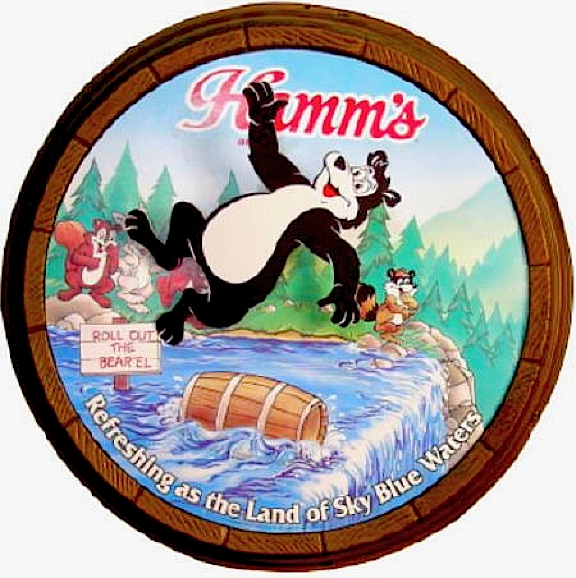
ANOTHER
SATISFIED CUSTOMER
Shoppers
in a Wisconsin grocery store spotted a black bear weighing about 123
pounds and standing five feet tall in the aisles making a bee-line for
the Hamm's beer shelf. He spent an hour in the store before being
tranquilized and removed back to the wild. Locals pointed out
that Hamm's uses a bear on its logo.
TRAVEL ARTICLES
WE NNNNNEVER
FINISHED READING
“`Oh, isn’t it wonnnnnnderful! I think he’s going to make a speech!' exclaimed Loulou Van Damme, a spry, sixtysomething hotelier and interior designer of Belgian descent, done up like Auntie Mame-Sahib in a flowing kurta and knuckle-dusting rings. We were enraptured by a beige, golf ball–size frog poised regally on the showerhead in one of the vast en suite bathrooms at Panchavatti, Van Damme’s guesthouse on North Goa’s Mapusa River."--Alexandra Marshall, "Exploring Goa's Glamour," Travel & Leisure (October 2009)
~~~~~~~~~~~~~~~~~~~~
✉ Guidelines for submissions: QUICK BYTES publishes only events, special dinners, etc, open to the public, not restaurant openings or personnel changes. When submitting please send the most pertinent info, incl. tel # and site, in one short paragraph as simple e-mail text, WITH DATE LISTED FIRST, as below. Thanks. John Mariani
IMPORTANT NOTE: Owing to
the number of Christmas holiday and New Year's announcements received, QUICK
BYTES can only list the most unusual.
* From Dec. 11-30 in San
Francisco, Ozumo offers
Dom Perignon champagne for the celebratory price of $35 a glass and
$179 per bottle (regular price is $295.00). Call 415-882-1333.
www.Ozumo.com.
* From Dec. 13-Feb. 28, in NYC,
Executive Chef & Owner
Ralf Kuettel of Trestle on Tenth
presents “Traditional Swiss Fondue Sundays," served with
traditional accoutrements including: bread cubes for dunking,
bündnerfleisch, speck, steamed potatoes, and cornichons. $24 pp.
Call 212-645-5659 or visit www.trestleontenth.com.
On Dec. 17 in San
Mateo, CA, Acqua Pazza owners,
Enzo, Tullio and Valerio Rosano will host a dinner with Slow Food San
Francisco Founder, Lorenzo Scarpone to benefit the Galano Dairy Farm in
Fossa, Abruzzo. with 50% of the proceeds to used to help build a
temporary shelter for the Galano's cows before the harsh winter snow
and wind set in. The 4-course dinner is $75 pp. Call
650-375-0903; www.acqua-pazza.com.
* On Dec. 24 in Brooklyn, NY,
SAUL Restaurant, will be
celebrating
The Feast of the Seven Fishes with a special six-course menu. $80
pp. call 718-935-9844.
~~~~~~~~~~~~~~~~~~~~~~~~~~~
Everett Potter's Travel Report:

~~~~~~~~~~~~~~~~~~~~~~~~~~~~~~~~~~~~~~~~~~~~~~~~~~~~~~~~~~~~~~~~~~~~~~~~~~
Eating Las Vegas is the new on-line site for Virtual Gourmet contributor John A. Curtas., who since 1995 has been commenting on the Las Vegas food scene and reviewing restaurants for Nevada Public Radio. He is also the restaurant critic for KLAS TV, Channel 8 in Las Vegas, and his past reviews can be accessed at KNPR.org. Click on the logo below to go directly to his site.
~~~~~~~~~~~~~~~~~~~~~~~~~~~~~~~~~~~~~~~~~~~~~~~~~~~~~~~~~~~~~~~~~~~~~~~~~~~
Tennis Resorts Online: A Critical Guide to the World's Best Tennis Resorts and Tennis Camps, published by ROGER COX, who has spent more than two decades writing about tennis travel, including a 17-year stretch for Tennis magazine. He has also written for Arthur Frommer's Budget Travel, New York Magazine, Travel & Leisure, Esquire, Money, USTA Magazine, Men's Journal, and The Robb Report. He has authored two books-The World's Best Tennis Vacations (Stephen Greene Press/Viking Penguin, 1990) and The Best Places to Stay in the Rockies (Houghton Mifflin, 1992 & 1994), and the Melbourne (Australia) chapter to the Wall Street Journal Business Guide to Cities of the Pacific Rim (Fodor's Travel Guides, 1991).

Family Travel
Forum: The
Family Travel Forum (FTF), whose motto is "Have Kids, Still Travel!",
is dedicated to the ideals, promotion and support of travel with
children. Founded by business professionals John Manton and Kyle
McCarthy with first class travel industry credentials and global family
travel experience, the independent, family-supported FTF will provide
its members with honest, unbiased information, informed advice and
practical tips; all designed to make traveling a rewarding, healthy,
safe, better value and hassle-free experience for adults and children
who journey together. Membership in FTF will lead you to new worlds of
adventure, fun and learning. Join the movement.
All You Need to Know Before You Go
nickonwine: An engaging, interactive wine column by Nick Passmore, Artisanal Editor, Four Seasons Magazine; Wine Columnist, BusinessWeek.com; nick@nickonwine.com; www.nickonwine.com.

MARIANI'S VIRTUAL GOURMET NEWSLETTER is published weekly. Editor/Publisher: John Mariani.
Contributing Writers: Robert Mariani,
John A. Curtas, Edward Brivio, Mort
Hochstein, Suzanne Wright, and Brian Freedman. Contributing
Photographers: Galina Stepanoff-Dargery, Bobby Pirillo. Technical
Advisor: Gerry McLoughlin.
Any of John Mariani's books below
may be ordered from amazon.com by clicking on the cover image.
 My
newest book, written with my brother Robert Mariani, is a memoir of our
years growing up in the My
newest book, written with my brother Robert Mariani, is a memoir of our
years growing up in the For those of you who don't think of the Robert and I think you'll enjoy this very personal look at our --John Mariani |
 |
 |
 |
 |
 |
 |
© copyright John Mariani 2009
